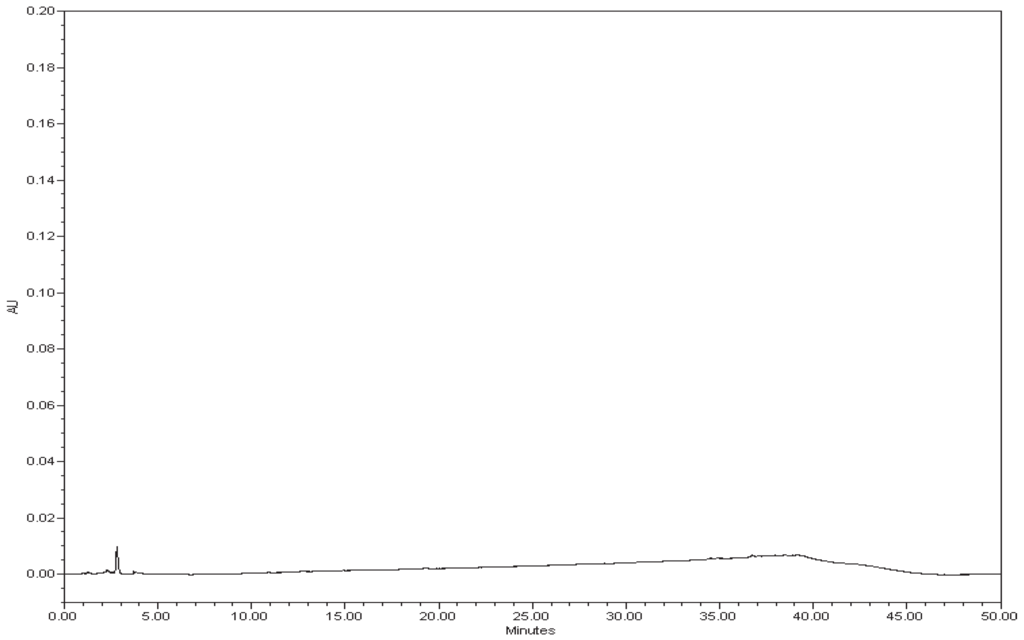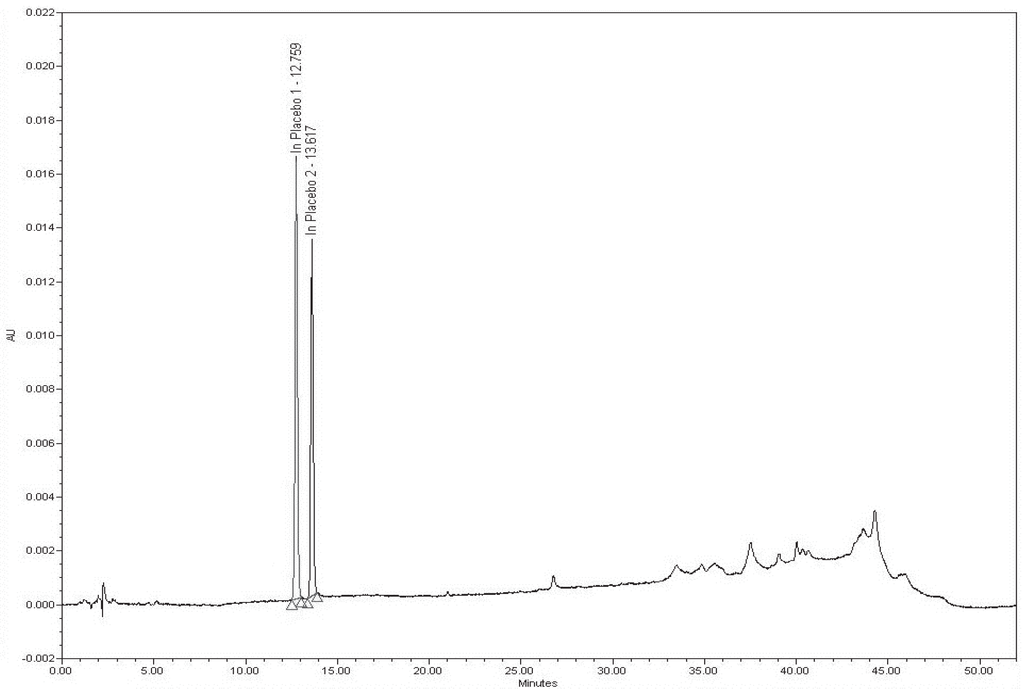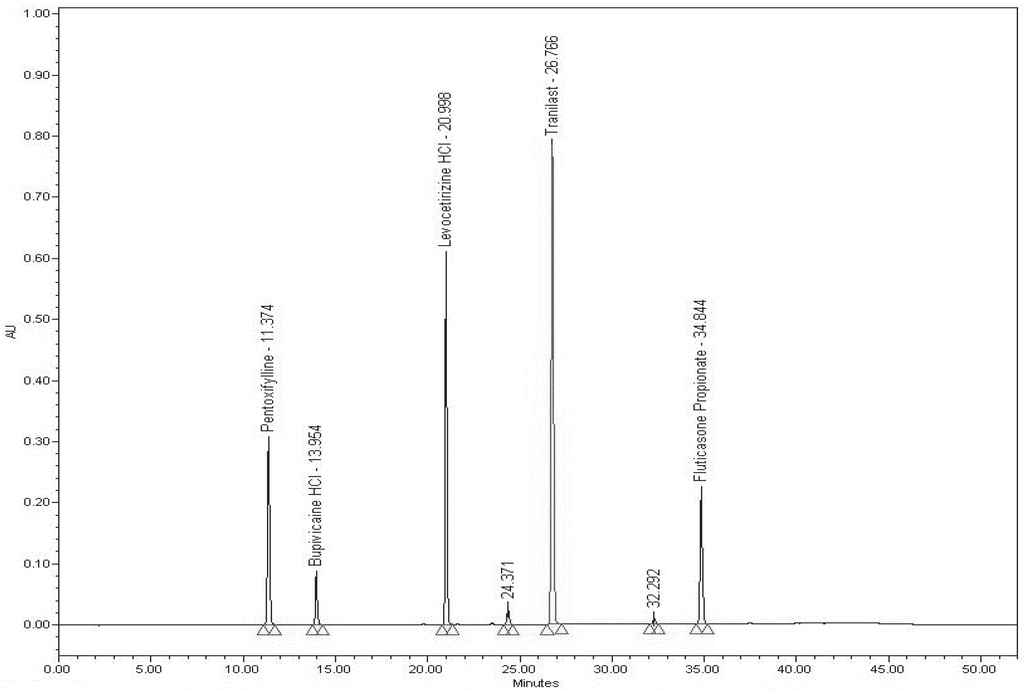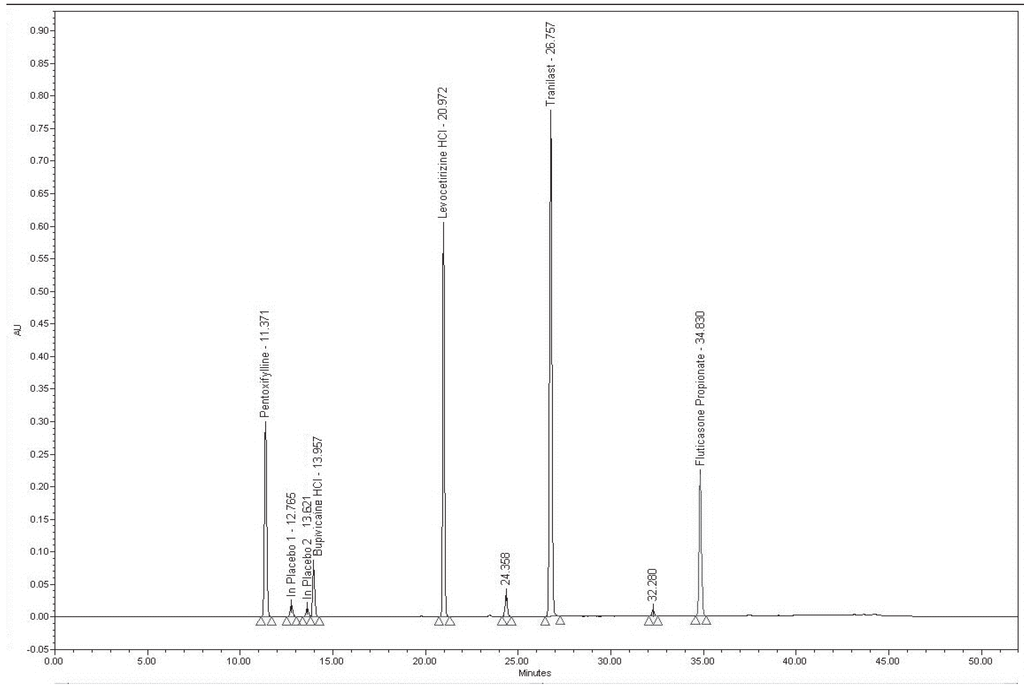Abstract
This article details the elements used in the verification method for the simultaneous high performance liquid chromatography (HPLC) assay of Pentoxifylline, Bupivacaine HCl, Levocetirizine HCl, Tranilast, and Fluticasone Propionate in Humco™ Sanare Advanced scar base. The method was proven to be linear over 50%–150% of the nominal concentration of the standard. The method was proven to be accurate over 50%–150%, with 98%–102% recovery of the actives from spiked placeboes over that range. The method exhibited specificity to the analytes listed, and it was shown to be precise, yielding acceptable results for system reproducibility and method repeatability. The method, as written, is considered to have been verified.
1. Introduction
Compounded formulations in silicone oil based creams containing Pentoxifylline, Bupivacaine HCl, Levocetirizine HCl, Tranilast, and Fluticasone Propionate are applied to scars to facilitate further healing of scar tissue while also minimizing the appearance of those scars. This particular active formulation facilitates the healing of scar tissue by containing a drug (Tranilast [1,2,3]), which reduces collagen formation in fibroblasts and inhibits the action of neurofibroma cells in keloid and hypertrophic scars. An antihistamine (Levocetirizine HCl [4,5]) drug is also incorporated, which prevents the release of endogenous inflammatory response factors and increases blood flow at the topical site of action. This formulation also contains anti-inflammatory drugs (Pentoxifylline [6] and Fluticasone Propionate [7]) along with a topical pain management drug (Bupivacaine HCl [8]). Additionally, Pentoxifylline has been shown to decrease collagen production while increasing the activity of collagenase in the dermis, thereby promoting the turnover of dermal cells [9,10]. Together these actives have been shown to be particularly effective at stimulating skin renewal on scar tissue, while reducing inflammation that might occur in healing scars.
Humco™ Sanare scar base is an anhydrous topical compounding base, containing silicone oils and polyethylene glycol (PEG) substituted silicones along with PEG substituted fixed oils which form a non-washable barrier that is uniquely suitable for application as scar therapy and for reducing symptoms of other skin conditions [11]. Additionally, Sanare contains an anti-inflammatory botanical agent, Carapa Guaianensis seed oil, a natural ingredient that promotes skin renewal and encourages healing of scar tissue [12,13,14]. Humco™ Sanare scar base has a smooth elegant yet non-greasy texture and is appropriate for application of compounded medications to areas that have begun to heal from burns, ulcers, abrasions, and other dermal injuries.
This report details the method verification requirements and corresponding acceptance criteria for the analytical method used to assay Pentoxifylline, Bupivacaine HCl, Levocetirizine HCl, Tranilast, and Fluticasone Propionate compounded in Humco™ Sanare scar base. Following verification, the method is suitable for analyzing samples compounded in-house and samples received from other pharmacies for analytical testing [15,16,17]. The ingredients in the formulation are listed in Table 1.

Table 1.
Compounded formulation in Humco™ Sanare scar base.
2. Experimental Section
A reverse phase high performance liquid chromatography (HPLC) method was developed which uses a phosphate solution and acetonitrile to create a gradient to separate the components contained in the formulation. The details of the method, including HPLC instrument conditions, mobile phase preparation, and preparation of standards and samples are given. The method verification elements and acceptance criteria are also given.
2.1. Materials and Methods
2.1.1. Chromatographic Conditions
Column: Phenomenex® Gemini 150 × 4.6 mm C18 5 µm Part # 00F-4435-E0 or equivalent (Phenomenex, Torrance, CA, USA); Guard column: Phenomenex® SecurityGuard C18 Guard Column Part # KJ0-4282 (Phenomenex, Torrance, CA, USA); Column temperature: 25 °C; Mobile Phase A: 0.02 M Sodium phosphate dibasic, pH 3.0 with o-phosphoric acid; Mobile Phase B: Acetonitrile; Gradient profile: See Table 2.

Table 2.
Mobile phase gradient profile.
Flow rate: 1.0 mL/min; Injection volume: 10 µL; Wavelength: 220 nm; Seal/needle rinse: 50/50 Acetonitrile/water; Run time: 52 min; Typical retention times: See Table 3.

Table 3.
Typical retention times of actives.
2.1.2. Materials and Equipment
Pentoxifylline: United States Pharmacopeia or reference standard grade (Spectrum Chemical, Gardena, CA, USA); Bupivacaine HCl: United States Pharmacopeia or reference standard grade (Spectrum Chemical, Gardena, CA, USA); Levocetirizine HCl: United States Pharmacopeia or reference standard grade (Fisher Scientific, Pittsburgh, PA, USA); Tranilast: United States Pharmacopeia or reference standard grade (Fisher Scientific, Pittsburgh, PA, USA); Fluticasone Propionate: United States Pharmacopeia or reference standard grade (Fisher Scientific, Pittsburgh, PA, USA); Sodium phosphate dibasic: Reagent grade (Fisher Scientific, Pittsburgh, PA, USA); HPLC grade water: HPLC grade (Fisher Scientific, Pittsburgh, PA, USA); Acetonitrile: HPLC grade (Fisher Scientific, Pittsburgh, PA, USA); o-Phosphoric acid, 85%: HPLC grade (Fisher Scientific, Pittsburgh, PA, USA); Tetrahydrofuran: HPLC grade (Fisher Scientific, Pittsburgh, PA, USA); Humco™ Sanare scar base (Humco, Texarkana, TX, USA); Syringe filter: Whatman 25 mm GD/XF Syringe Filter with 0.45 µm PTFE Filter media Part #6974-2504 or equivalent (GE Sciences, Pittsburgh, PA, USA).
2.1.3. Mobile Phase A Preparation
A 1000-mL portion of purified water and 2.9 g sodium phosphate dibasic were combined and mixed well. The pH of the solution was adjusted to 3.0 ± 0.1 with o-phosphoric acid 85%.
2.1.4. Diluent (75/25 Water/Acetonitrile)
A 750-mL portion of HPLC grade water and 250 mL of acetonitrile were combined and mixed well. Volumes were scaled as necessary.
2.1.5. Standard Preparation
For the Stock Standard, actives were accurately weighed, to the nearest 0.1 mg. A quantity of 40 mg of Pentoxifylline, 20 mg of Bupivacaine HCl, 40 mg of Levocetirizine HCl, 40 mg Tranilast, and 20 mg of Fluticasone Propionate was transferred into a 100-mL volumetric flask. A 5-mL portion of THF was added along with 45 mL of acetonitrile to the flask. The solution was sonicated for about 5 min to dissolve the actives, and then the flask was diluted to volume with diluent. This was the Stock Standard solution.
For the Working Standard Solution, an aliquot of 5 mL of the Stock Standard solution was pipetted into a 10 mL volumetric flask. This solution was diluted to volume with diluent. This was the Working Standard solution.
2.1.6. Sample Preparation
For the Working Sample solution, about 2 g of the sample was weighed into a 200 mL volumetric flask. About 10 mL of THF was added to the flask followed by 90 mL of acetonitrile, and the sample was allowed to fully disperse with sonication. The flask was then diluted to volume with diluent. No further dilution was necessary. This was the Working Sample solution. Approximately, 3 mL of the sample was filtered using a 0.45 µm PTFE syringe filter into an appropriate HPLC vial for analysis.
2.2. Method Verification Elements
The following analytical method verification sections detail the documentation required to verify the performance characteristics of the procedure and ensure that it meets the requirements for the intended analytical applications. The acceptance criterion was the successful completion of each section. The verification included specificity, linearity, accuracy, and precision (system precision, or reproducibility, and method precision, or repeatability), and range [15,16,17].
2.2.1. Specificity
The specificity is the ability to assess unequivocally the analyte of interest in the presence of components that may be expected to be present, such as matrix components (preservatives or placebo peaks) or peaks in the blank. The Blank preparation and the Placebo preparation (Sanare scar base) were examined to ensure that no interference occurred at the retention time of any of the actives in the chromatograms.
2.2.2. Linearity
The linearity of an analytical procedure is its ability to elicit test results that are directly proportional to the concentration of the analyte in samples over a specified range. The analytical method must be shown to be linear over the range of 50%–150% of the nominal standard concentration, with the plot of concentration vs. analyte peak area for each analyte having a correlation coefficient (r2) of ≥0.99.
Limit of quantitation (LOQ) and limit of detection (LOD) for each of the actives should be determined by successive dilution of the Working Standard solution and applying the signal-to-noise ratio test to the resulting chromatograms. LOQ is the concentration at which the signal-to-noise ratio was about 10:1, while LOD is the concentration at which the signal-to-noise ratio was about 3:1.
2.2.3. Accuracy
The accuracy of an analytical procedure is the closeness of test results obtained by that procedure to the true value. The accuracy of this method should be verified by determining the recovery of a known amount of each analyte added to the sample matrix (a spiked placebo). The percent recovery of each analyte from the placebo spiked at 50%–150% of the nominal standard concentration should be determined to be 98%–102%. Additionally, the peak area % RSD (percent relative standard deviation) among sets of samples at each concentration must be ≤2.0%.
2.2.4. Precision
The precision of an analytical procedure is the degree of agreement among individual test results when the procedure is applied repeatedly to multiple samplings of a homogeneous sample. This is further broken down into system precision and method precision.
System Precision (Reproducibility)
The system precision or reproducibility evaluates the ability of the method to analyze a single preparation by injecting the sample six times. The peak area % RSD of each analyte among the six injections must be ≤2.0%.
Method Precision (Repeatability)
The method precision or repeatability evaluates the ability of the method to analyze multiple preparations of sample. This was determined by assaying three individual preparations injected in triplicate. The peak area % RSD of each analyte for the three individual preparations must be ≤2.0%.
2.2.5. Range
The range for an analytical procedure is established over the concentrations of the analytes where acceptable precision, accuracy, and linearity have been demonstrated. The range of the analytical method should be established by examining the precision, accuracy, and linearity studies.
3. Results and Discussion
3.1. System Suitability
System suitability of the method was proven using the parameters that are used by compendia to prove that the data generated are valid. The relative standard deviation of the peak area responses of Pentoxifylline, Bupivacaine HCl, Levocetirizine HCl, Tranilast, and Fluticasone Propionate for the first five consecutive injections and for all injections of the Working Standard solution was ≤2.0%. The relative standard deviation of the retention times of Pentoxifylline, Bupivacaine HCl, Levocetirizine HCl, Tranilast, and Fluticasone Propionate for all Working Standard injections was ≤0%. Theoretical plates for Pentoxifylline, Bupivacaine HCl, Levocetirizine HCl, Tranilast, and Fluticasone Propionate in the Working Standard solution were ≥2000. The tailing factor for Pentoxifylline, Bupivacaine HCl, Levocetirizine HCl, Tranilast, and Fluticasone Propionate in the Working Standard solution was ≤2.0. The resolution between each of the components of Pentoxifylline, Bupivacaine HCl, Levocetirizine HCl, Tranilast, and Fluticasone Propionate in the Working Standard solution was >1.5. No interference in the blank or placebo preparation (≥0.3%) was observed at the retention time of Pentoxifylline, Bupivacaine HCl, Levocetirizine HCl, Tranilast, and Fluticasone Propionate.
The system suitability met all acceptance criteria, therefore, the system was suitable to analyze the samples for further method verification elements.
Table 4 gives the system suitability results and specifications obtained during the method verification.

Table 4.
System Suitability of the high performance liquid chromatography (HPLC): n/a = not applicable. % RSD: percent relative standard deviation.
3.2. Specificity Results
3.2.1. Examining the Blank
The sample blank was assayed to verify that there are no significant peaks with similar retention times as Pentoxifylline, Bupivacaine HCl, Levocetirizine HCl, Tranilast, or Fluticasone Propionate. The Blank chromatogram exhibits no peaks (other than a small solvent front peak) beyond normal noise. There is a baseline ramp up to 39 min that is present, but this is a function of the gradient elution and not a true peak. No significant peaks (≥0.3% of the analytes of interest), beyond the noise level were noted in the sample blank near the retention times of the analytes of interest.
3.2.2. Examining the Sample Matrix (Placebo)
The sample matrix without the active ingredient (also known as a placebo)—Humco™ Sanare scar base in this case—was assayed to verify that there are no significant peaks with similar retention times as Pentoxifylline, Bupivacaine HCl, Levocetirizine HCl, Tranilast, or Fluticasone Propionate. There were two an identified peaks (In Placebo 1 and In Placebo 2) in the Placebo chromatogram, representing components of the botanical extract contained in the product. These peaks do not interfere with analysis of the actives as they do not occur at the actives’ retention times. As such, no significant peaks (≥0.3% of the analytes of interest) were noted in the Placebo sample matrix near the retention time of the analytes of interest. Unidentified small peaks (retention time = 24.3 and 32.2 min) in the Standard and Sample chromatograms are process impurities of Tranilast that are present in the raw material.
Blank, Placebo, Working Standard, and Sample chromatograms are given in Figure 1, Figure 2, Figure 3 and Figure 4.

Figure 1.
Blank chromatogram.

Figure 2.
Placebo (Humco™ Sanare scar base) chromatogram.

Figure 3.
Working Standard solution chromatogram.

Figure 4.
Sample preparation chromatogram.
3.2.3. Specificity Discussion
There was no interference in the blank or Placebo (Humco™ Sanare scar base) chromatograms at the retention times of Pentoxifylline, Bupivacaine HCl, Levocetirizine HCl, Tranilast, or Fluticasone Propionate. Therefore, the acceptance criteria for Specificity of Pentoxifylline, Bupivacaine HCl, Levocetirizine HCl, Tranilast, or Fluticasone Propionate are met.
3.3. Linearity Results
Linearity for Pentoxifylline, Bupivacaine HCl, Levocetirizine HCl, Tranilast, or Fluticasone Propionate was conducted over a range of 50%–150% of the nominal analytes in the prepared sample concentration. Five concentrations were tested within the range of 50%–150%.
3.3.1. Experiments
The Stock Standard solution of Pentoxifylline, Bupivacaine HCl, Levocetirizine HCl, Tranilast, or Fluticasone Propionate was prepared. The linearity was accomplished by making injections of varying volumes of the Working Standard solution. During calibration of the HPLC, the injection volumes are verified for accuracy over the stated range; therefore, this method for testing linearity of the components is acceptable. For example, for the 50% level, 5 µL of the Working Standard was injected; for the 80% level, 8 µL of the Working Standard was injected; for the 100% level, 10 µL of the Working Standard was injected; for the 120% level, 12 µL of the Working Standard was injected; and for the 150% level, 15 µL of the Working Standard was injected. Serial dilutions of the Working Standard were made to determine the approximate LOQ and LOD of the five actives.
Table 5 gives the Stock Standard weights for each compound and the effective concentrations (mg/mL) represented by the varied injection volumes for each of the linearity levels.

Table 5.
Concentrations of each active used in the linearity and accuracy evaluations. (Conc.: concentration).
3.3.2. Linearity of Actives
Table 6 gives the linearity results for each active in the method verification, while Table 7 gives the LOQ and LOD concentrations of each active as determined in the method verification.

Table 6.
The linearity level, theoretical and actual concentrations, and percent recovery as well as the r2-value (correlation coefficient) for each active.

Table 7.
Limit of quantitation (LOQ) and limit of detection (LOD) concentrations for each active (determined by signal to noise ratio).
3.3.3. Linearity Discussion
The correlation coefficient (r2) from the plotted area response versus concentration for Pentoxifylline is 0.9999, which is ≥0.99; for Bupivacaine HCl is 0.9999, which is ≥0.99; for Levocetirizine HCl is 0.9999, which is ≥0.99; for Tranilast is 0.9999, which is ≥0.99; and for Fluticasone Propionate is 0.9999, which is ≥0.99. The data used for calculation of the linearity are represented in Table 6.
The average percent recovery for Pentoxifylline is 99.7%–100.3%, which is in the range 98%–102%; for Bupivacaine HCl is 99.6%–100.3%, which is in the range 98%–102%; for Levocetirizine HCl is 99.6%–100.3%, which is in the range 98%–102%; for Tranilast is 99.7%–100.3%, which is in the range 98%–102%; and for Fluticasone Propionate is 99.6%–100.4%, which is in the range 98%–102% of the amount prepared for the 50%–150% level.
All acceptance criteria for the linearity of Pentoxifylline, Bupivacaine HCl, Levocetirizine HCl, Tranilast, and Fluticasone Propionate are met.
3.4. Accuracy Results
The accuracy of the method was proven by using spiked placebo solutions that were prepared by spiking in the appropriate amount of the analytes of interest into the sample matrix and assayed using a standard. The spiked placebo preparation spiked with each of the analytes of interest (Pentoxifylline, Bupivacaine HCl, Levocetirizine HCl, Tranilast, and Fluticasone Propionate) over a range of 50%–150% of the nominal standard concentration. These solutions were assayed, and the data were compared with the amount prepared versus the amount recovered.
3.4.1. Accuracy of Actives
The concentrations of the spiked placebo solutions were the same as those represented in Table 5, and results of the accuracy evaluation are given in Table 8.

Table 8.
Accuracy level, theoretical and actual concentrations of each active, percent recovery of each active, and the % RSD of triplicate injections at each accuracy level for each active.
3.4.2. Accuracy Discussion
The recovery for the Pentoxifylline, Bupivacaine HCl, Levocetirizine HCl, Tranilast, and Fluticasone Propionate was within the acceptance criteria of 98%–102%. The % RSD among the accuracy preparations was ≤2.0% RSD, meeting the acceptance criteria.
The accuracy of Pentoxifylline, Bupivacaine HCl, Levocetirizine HCl, Tranilast, and Fluticasone Propionate meets the acceptance criteria.
3.5. Precision Results
The system precision (reproducibility) and method precision (repeatability) were evaluated using preparations of the spiked placebo. The system precision evaluated the ability of the method to analyze a single sample preparation by injecting the sample six times. The method precision evaluated the ability of the method to analyze multiple preparations of sample. This was determined by assaying three individual preparations.
3.5.1. System Precision Results
System precision (reproducibility) results are given in Table 9.

Table 9.
System precision results (% RSD) for six injections of a single sample preparation.
3.5.2. System Precision Discussion
The % RSD for the Pentoxifylline, Bupivacaine HCl, Levocetirizine HCl, Tranilast, and Fluticasone Propionate peak areas for the six replicate injections is ≤2.0%. The system precision acceptance criteria are met.
3.5.3. Method Precision Results
Method Precision (Repeatability) results are given in Table 10.

Table 10.
Method precision results (% RSD) for three individual preparations of a sample.
3.5.4. Method Precision Discussion
The % RSD for the Pentoxifylline, Bupivacaine HCl, Levocetirizine HCl, Tranilast, and Fluticasone Propionate peak areas for the three preparations is ≤2.0%. The method precision acceptance criteria are met.
3.6. Range Results and Discussion
The results of the precision, accuracy, and linearity each pass the respective specifications over the 50%–150% nominal range for each analyte specified in this study. The range for the method is concluded to be 50%–150% the nominal standard concentration of each analyte in the study.
4. Conclusions
The method verification elements of linearity, accuracy, specificity, precision, and range [15,16,17] met each of the respective elements’ acceptance criteria; therefore, the analytical method is considered to be verified for its intended purposes, as defined previously.
Acknowledgments
The author wishes to thank the Humco Holding Group Board of Directors for approving funding for the work performed in this study.
Conflicts of Interest
The author declares no conflict of interest.
References
- Yamamoto, M.; Yamauchi, T.; Okano, K.; Takahashi, M.; Watabe, S.; Yamamoto, Y. Tranilast, an anti-allergic drug, down-regulates the growth of cultured neurofibroma cells derived from neurofibromatosis type. Tohoku J. Exp. Med. 2009, 217, 193–201. [Google Scholar] [CrossRef] [PubMed]
- Tranilast Inhibits Cytokine-Induced Nuclear Factor κB Activation in Vascular Endothelial Cells. Available online: http://molpharm.aspetjournals.org/content/62/4/856.full (accessed on 1 December 2015).
- Tranilast, a Selective Inhibitor of Collagen Synthesis in Human Skin Fibroblasts. Available online: http://jb.oxfordjournals.org/cgi/content/abstract/116/4/892 (accessed on 1 December 2015).
- Grant, J.A.; Riethuisen, J.M.; Moulaert, B.; DeVos, C.; Gamalero, C.; Descalzi, D.; Folli, C.; Passalacqua, G.; Canonica, G.W. A double-blind, randomized, single-dose, crossover comparison of levocetirizine with ebastine, fexofenadine, loratadine, mizolastine, and placebo: Suppression of histamine-induced wheal-and-flare response during 24 hours in healthy male subjects. Ann. Allergy Asthma Immunol. 2002, 88, 190–197. [Google Scholar] [CrossRef]
- Pasquali, M.; Baiardini, I.; Rogkakou, A.; Riccio, A.M.; Gamalero, C.; Descalzi, D.; Folli, C.; Passalacqua, G.; Canonica, G.W. Levocetirizine in persistent allergic rhinitis and asthma: Effects on symptoms, quality of life and inflammatory parameters. Clin. Exp. Allergy 2006, 36, 1161–1167. [Google Scholar] [CrossRef] [PubMed]
- Trental, Pentoxil (pentoxifylline) dosing, indications, interactions, adverse effects, and more. Available online: http://reference.medscape.com/drug/trental-pentoxil-pentoxifylline-342179 (accessed on 3 December 2015).
- Rhen, T.; Cidlowski, J.A. Anti-inflammatory action of glucocorticoids—New mechanisms for old drugs. N. Engl. J. Med. 2005, 353, 1711–1723. [Google Scholar] [CrossRef] [PubMed]
- Bupivacaine Hydrochloride: The American Society of Health-System Pharmacists. Available online: http://www.drugs.com/monograph/bupivacaine-hydrochloride.html (accessed on 2 May 2015).
- Pentoxifylline: A drug with wide spectrum applications in dermatology. Available online: http://escholarship.org/uc/item/6270c6vm (accessed on 30 November 2015).
- Ward, A.; Clissold, S.P. Pentoxifylline. A review of its pharmacodynamic and pharmacokinetic properties, and its therapeutic efficacy. Drugs 1987, 34, 50–97. [Google Scholar] [CrossRef] [PubMed]
- Zatz, J.L.; Steinberg, D.C. Topical protective and cosmetic products. In Transdermal and Topical Drug Delivery Systems; Ghosh, T.K., Pfister, W.R., Su, Y., Eds.; Interpharm Press Inc.: Inglewood, CO, USA, 1997; Chapter 17; p. 624. [Google Scholar]
- Nayak, B.; Kanhai, J.; Milne, D.M.; Pereira, L.P.; Swanston, W.H. Experimental Evaluation of Ethanolic Extract of Carapa guianensis L. Leaf for Its Wound Healing Activity Using Three Wound Models. Evid. Based Complement. Alternat. Med. 2009. [Google Scholar] [CrossRef] [PubMed]
- Hammer, M.L.; Johns, E.A. Tapping an Amazonian plethora: Four medicinal plants of Marajó Island, Pará (Brazil). J. Ethnopharmacol. 1993, 40, 53–75. [Google Scholar] [CrossRef]
- Nayak, B.; Kanhai, J.; Milne, D.M.; Swanston, W.H.; Mayers, S.; Eversley, M.; Rao, A.V. Investigation of the wound healing activity of Carapa guianensis L. (Meliaceae) bark extract in rats using excision, incision, and dead space wound models. J. Med. Food 2010, 13, 1141–1146. [Google Scholar] [CrossRef] [PubMed]
- Validation of Compendial Procedures; United States Pharmacopoeia. Available online: http://www.ofnisystems.com/wp-content/uploads/2013/12/USP36_1225.pdf (accessed on 15 August 2015).
- Validation of Analytical Procedures: Text and Methodology. Available online: http://www.ich.org/products/guidelines/quality/quality-single/article/validation-of-analytical-procedures-text-and-methodology.html (accessed on 1 August 2015).
- Guidance for Industry: Analytical Procedures and Methods Validation for Drugs and Biologics; Food and Drug Administration Center for Drug Evaluation Research: Silver Spring, MD, USA, 2015.
© 2016 by the author; licensee MDPI, Basel, Switzerland. This article is an open access article distributed under the terms and conditions of the Creative Commons Attribution (CC-BY) license (http://creativecommons.org/licenses/by/4.0/).